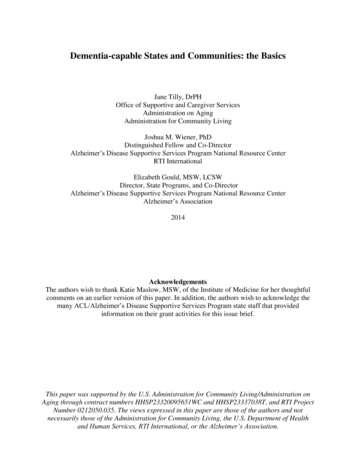
Transcription
This thesis has been submitted in fulfilment of the requirements for a postgraduate degree(e.g. PhD, MPhil, DClinPsychol) at the University of Edinburgh. Please note the followingterms and conditions of use:This work is protected by copyright and other intellectual property rights, which areretained by the thesis author, unless otherwise stated.A copy can be downloaded for personal non-commercial research or study, withoutprior permission or charge.This thesis cannot be reproduced or quoted extensively from without first obtainingpermission in writing from the author.The content must not be changed in any way or sold commercially in any format ormedium without the formal permission of the author.When referring to this work, full bibliographic details including the author, title,awarding institution and date of the thesis must be given.
An Investigation of Dementia Screening Tools in a Cohortwith Down syndrome and Intellectual DisabilityLaura WilliamsDoctorate in Clinical PsychologyThe University of EdinburghSeptember 20151
D. Clin. Psychol. Declaration of own workThis sheet must be filled in (each box ticked to show that the condition has been met), signed and dated, andincluded with all assessments - work will not be marked unless this is doneName:Laura WilliamsAssessed work:ThesisTitle of work:An Investigation of Dementia Screening Tools in a Cohort with Down Syndromeand Intellectual DisabilityI confirm that all this work is my own except where indicated, and that I have: Read and understood the Plagiarism Rules and Regulations in the Programme Handbook Composed and undertaken the work myself Clearly referenced/listed all sources as appropriate Referenced and put in inverted commas any quoted text of more than three words (from books, web, etc) Given the sources of all pictures, data etc. that are not my own Not made undue use of essay(s) of any other student(s) either past or present (or where used,this has been referenced appropriately) Not sought or used the help of any external professional agencies for the work (or where used,this has been referenced appropriately) Not submitted the work for any other degree or professional qualification except as specified Acknowledged in appropriate places any help that I have received from others (e.g. fellow students,technicians, statisticians, external sources) Complied with other plagiarism criteria specified in the Programme Handbook I understand that any false claim for this work will be penalised in accordance with the University regulationsSignatureL WilliamsDate11.09.15Please note:a) If you need further guidance on plagiarism, you can:i/ Speak to your director of studies or supervisorii/ View university regulations ndex.htmb) Referencing for most assessed work should be in the format of the BPS style guide, which is freely availablefrom the BPS web site.2
ACKNOWLEDGEMENTSFirstly, I would like to thank the Psychology department in NHS Fife. It has been a nurturingand influential place to train. In particular, I wish to thank Dr Alison Robertson. I havebenefitted greatly and learned much from your approach. I would also like to thank Dr JillJones, whose support and containment over the course of the project has been invaluable. Tomy academic supervisors, Dr Ken MacMahon and Dr Emily Newman, thank you for yourguidance throughout.To the Fife trainees, past and present. Our shared experience has got me to the finish line.Thank you for always being there to turn to.To my friends and family, Mum and Dad. I want to thank you for all the many and variedways you have each contributed to this outcome. This would not have been possible withoutyou.The topic of my thesis has mirrored life over recent months. This reflection has been bothconfronting and a motivation. To those in my family who knew and know the pain of dementia.Finally, to Matty and Ella. Thank you for always keeping me grounded in our everyday. Thisis for you.Laura WilliamsSeptember 20153
1. THESIS ABSTRACTObjectives: The following thesis is presented within two separate pieces of work. A systematicliterature review (SLR) aimed to evaluate the individual characteristics and psychometricproperties of four dementia screening tools. These were the Dementia Questionnaire for Peoplewith Learning Disabilities (DLD) (Evenhuis, 2007), the Dementia Scale for Down Syndrome(DSDS) (Gedye, 1995), the Dementia Screening Questionnaire for Individuals with IntellectualDisabilities (DSQIID) (Deb et al, 2007a) and the Adaptive Behaviour Dementia Questionnaire(ABDQ) (Prasher et al, 2004). The empirical research (ER) aimed to evaluate the clinical utilityand longitudinal accuracy of two of these tools; the DLD and the ABDQ in a clinical populationwith intellectual disability (ID) and Down syndrome (DS).Methods: For the SLR a comprehensive list of electronic academic databases were searchedto identify studies which included information relating to the psychometric properties of theDLD, DSDS, DSQIID and the ABDQ. Information within the studies was then extracted andrated using two quality assessment measures. These were the Characteristics of AssessmentInstruments for Psychiatric Disorders in Persons with Intellectual Developmental Disabilities(CAPS-IDD) (Zeilinger et al, 2013b) and the Qualsyst (Kmet, 2004). For the ER, a repeatedmeasures MANOVA was used to assess change over time between two groups of people withintellectual disabilities and Down syndrome; one with dementia and one without.Results: In the SLR, 16 studies were identified and rated using the CAPS-IDD and theQualsyst. Detailed information related to the dementia screening tools and quality ratings ofthe papers are provided.In the ER both the ABDQ and the DLD demonstrated a clear difference between those whodevelop dementia and those who do not, with those in the ‘dementia’ group exhibitingincreasing scores over time.4
Conclusions: The SLR concludes that the evidence base for these dementia screening toolsremain limited. The largest evidence base was evidenced for the DLD.The ER concludes that the ABDQ and the DLD are useful tools to differentiate between thosewho develop dementia and those who do not. Further analysis incorporating the exploration ofindividual component items of tools is recommended.Word Count: 21,1965
TABLE OF CONTENTSDeclaration of Own Work2Acknowledgements3Thesis Abstract4Thesis Preface and Structure9Section 1: Systematic Review10-50A Systematic Review of the Characteristics and Psychometric Properties of FourAssessments Tools for Dementia Screening in people with Intellectual DisabilitiesAbstract101. Introduction11-161.1Screening in Intellectual Disabilities13-162. Method17-202.1 Literature Search172.2 Inclusion/Exclusion Criteria17-182.3 Coding of Dementia Screening Tools and Relevant Studies18-203. Results20-313.1 Literature Search20-21-Figure 1. PRISMA flow diagram of search strategy and results3.2 Quality Assessment – CAPS-IDD/QualsystTable 1. Summary Findings CAPS-IDD - Dementia Questionnaire for People2122-3122-24with Learning Disabilities (DLD)6
Table 2. Summary Findings CAPS-IDD - Dementia Scale for24-26Down Syndrome (DSDS)Table 3. Summary Findings CAPS-IDD -Dementia Screening26-29Questionnaire for Individuals with Intellectual Disabilities (DSQIID)Table 4. Summary Findings CAPS-IDD - Adaptive Behaviour29-31Dementia Questionnaire (ABDQ)4. Discussion32-504.1 Comparison of Screening Tools32-264.2 Strengths and Limitations of Current Review36-375. ConclusionsAppendices3839-43Appendix 1. Study Quality PaperReferences43-50Section 2. Journal Article51-80An Investigation of Dementia Screening Tools in a Cohort with Down Sydromeand Intellectual DisabilityAims and HypothesesAbstract51-52541. Introduction54-601.1 Screening Tools56-581.2 Local Procedure587
2. Method592.1 Participants592.2 Data Collection2.3 Data Analysis Strategy3. Results59-606061-723.1 ABDQ Main Results623.2 DLD Main Results643.3 SCS Main Results663.4 SOS Main Results693.5 Repeated Measures MANOVA71-723.6 Receiver Operating Curve Analysis4. Discussion4.1 Limitations of Current Research4.2 Clinical Relevance72-757273-744.3 Recommendations for Future Research755. erences76-80AppendicesAppendix 1: Table reproduced from Jones et al (2010)Appendix 2: Journal of Applied Research in Intellectual Disabilities (JARID)Author GuidelinesAppendix 3: Data Recording SheetsAppendix 4: Caldicott Approval FormsAppendix 5: Ethics Letter8
THESIS PREFACE AND STRUCTUREThis thesis is about the psychometric properties and utility of tools and questionnaires used toscreen and diagnose dementia in people with a learning disability. The thesis is presented in aportfolio format. The first section comprises a systematic review that focuses on the contentof psychometric tools and measures used to screen for dementia in this population. Thesecond is a piece of empirical research which investigates the use of specific tools, theDementia Questionnaire for people with Intellectual Disabilities (DLD) and the AdaptiveBehaviour Dementia Questionnaire (ABDQ). The empirical research uses longitudinal datafrom a clinical sample of people with intellectual disability and Down Syndrome.Both sections follow the publication guidelines for The Journal of Applied Research inIntellectual Disabilities (JARID). In addition, The Preferred Reporting Items for SystematicReviews and Meta-Analyses (PRISMA Group, 2009) was used to inform the methodsemployed in writing the systematic review. A list of references is included for each separatesection immediately after the main body of the text for each. The guidelines for publication inThe Journal of Applied Research in Intellectual Disabilities are included in the thesisappendices.9
A Systematic Review of the Characteristics and Psychometric Properties ofFour Assessment Tools for Dementia Screening in People with IntellectualDisabilitiesLaura Williams, Jill Jones, Ken McMahon, Emily Newman*Learning Disability Psychology Service, Lynebank Hospital, Halbeath Road, Dunfermline, KY114UWAbstractBackground: There are a number of assessment tools available to support the process ofdiagnosing dementia in individuals with intellectual disability (ID). This review aimed toevaluate the characteristics and psychometric properties of four assessment tools that arerecommended in clinical practice for this purpose.Methods: A systematic literature search across five databases (CINAHL, PsycInfo, Medline,Scopus and Web of Science) was conducted. Relevant studies were identified and selectedusing defined inclusion/exclusion criteria. 26 full-text articles were hand-searched. Afterselection, 16 studies were rated using the Characteristics of Assessment Instruments forPsychiatric Disorders in Persons with Intellectual Disabilities (CAPS-IDD) (Zeilinger et al.,2013b). The CAPS-IDD provided a structured method of summarising the psychometricproperties and conceptual and measurement information regarding the dementia screeningtools.10
Additionally, the individual papers were rated using the Quality Assessment Criteria forEvaluating Primary Research Papers from a Variety of Fields (Qualsyst). A proportion ofpapers were rated independently by two researchers, as were two of the screening tools.Results: In total, 104 studies were identified from initial search criteria. After excludingduplicates, screening titles and abstracts, a total of 26 studies remained and these wereretrieved in full-text. Of these, 16 papers met the criteria for inclusion. The reviewhighlighted a limited literature base for all screening tools, other than the DLD. The qualityof the papers used to evidence them were also limited in quality.Conclusions: The review demonstrates the evidence base for the four dementia screeningtools remains limited. The DLD has the largest evidence base. Further validation studieswould allow for greater understanding of the psychometric properties and accuracy of thetools.Keywords: Dementia, Intellectual disability, Assessment, Screening, Systematic review1. IntroductionThe ICD-10 Classification of Mental and Behavioural Disorders guidelines (World HealthOrganisation, 1992) define dementia as ‘a syndrome due to disease of the brain, usually ofchronic or progressive nature, in which there is a disturbance of multiple higher corticalfunctions including memory, thinking, orientation, comprehension, calculation, learningcapacity, language and judgement. The impairments of cognitive function are commonly11
accompanied, and occasionally preceded, by deterioration in emotional control, socialbehaviour, or motivation’. There is no modified definition of dementia for those with anintellectual disability (ID). Dementia is not a disease in itself, but rather the term used todescribe a number of symptoms and features which co-exist in an accepted pattern of braindegeneration. Dementia is caused by a number of conditions and often these specific ‘types’of dementia are named after their cause. Common types of dementia include Alzheimer’sdisease, vascular dementia, dementia with lewy bodies, frontotemporal dementia and mixeddementia where both Alzheimer’s and vascular features can be observed (Dening and BabuSandilyan, 2015).There is no one accepted psychometric tool for the assessment of dementia in people with ID,either observer-rated or self report. Neuropsychological tools often used to screen fordementia in the general adult population such as the Mini Mental State Examination (MMSE)(Folstein, 1987) or the Addenbrookes Cognitive Examination – 3rd Edition (ACE) (Hodges,2012) cannot be used for people with ID as they assume a pre-morbid level of functioningwithin the average range; screening using such tools in people with ID would result indifficulties delineating pre-existing cognitive impairment from that associated with adementing process (Deb et al, 2007a). For these reasons many researchers regard tests andcriteria available for people without ID to be not applicable to those with ID (Prasher et al,2004). One further key difficulty in screening and diagnosing dementia in this population is12
the greater probability of physical health conditions in people with ID that can in some casesmimic dementia (Deb et al., 2007b). In those with Down Syndrome (DS), the risk of developingthese health conditions, which include cardiac problems, thyroid disorders, sensoryimpairments, reduced muscle tone and Alzheimer’s type dementia (ATD), at anearlier age is increased (Smith, 2001). This has major implications for potential differentialdiagnoses and what might usefully be included within screening and diagnostic tests as partof the wider diagnostic process.1.1 Screening in Intellectual DisabilityGiven this context, there has been a concerted effort among clinicians working withindividuals with ID to develop tools that bridge the existing gaps and allow for accuratescreening and timely diagnosis. In a recent systematic review, Zeilinger et al. (2013a) found114 available tools for the purpose of dementia screening. Of these, 79 instruments were tobe completed directly by the person with ID and 35 were informant-based instruments. Anadditional four test batteries were identified.Zeilinger et al. (2013a) noted that the intention of the review was to provide an overview ofavailable tools, acknowledging that they did not evaluate the instruments collected orexamine the psychometric properties or other characteristics. However, reviewing in moredetail the strengths and limitations across the available tools may allow for a comparison13
between specific tools. Furthermore, it might highlight specific areas for empirical research.Thorough analysis of the individual component parts or items included in the tools mightidentify those that are most likely to be helpful in dementia screening in this population. Ithas been argued that it is unlikely that a single tool can be found to accurately and reliablydetect dementia in people with ID (Prasher et al, 1995). However, if the most predictivecomponent sub-scales or individual items of the existing individual tools can be integrated,this may lead towards the development of a more reliable dementia screening tool in IDpopulations.The systematic review presented here replicates and extends the search strategy used byZeilinger et al. (2013a) to identify studies which have used any of four specific informantbased assessment tools. The tools chosen for review here are highlighted in the jointBritish Psychological Society (BPS) and Royal College of Psychiatrists (RCP) guideline‘Dementia and People with Intellectual Disabilities: Guidance on the assessment, diagnosis,interventions and support of people with intellectual disabilities who develop dementia’(BPS, 2009), as examples of best practice for assessing dementia. These are tools cliniciansare likely to consider when screening for dementia in people with ID within a UK contextand include the Dementia Questionnaire for People with Learning Disabilities (DLD;Evenhuis et al, 2007); The Dementia Scale for Down Syndrome (DSDS; Gedye, 1995);Adaptive Behaviour Dementia Questionnaire (ABDQ; Prasher et al, 2004); Dementia14
Screening Questionnaire for Individuals with Intellectual Disabilities (DSQIID; Deb et al,2007a).The DLD (Evenhuis, 2007) formerly known as the Dementia Questionnaire for People withMental Retardation (DMR) is a screening tool used to assist in the early detection ofdementia in people with a learning disability. First developed in 1980, it is completed by afamily member or carer often assisted by a healthcare professional. The DLD consists of 50items which are sub-divided into eight separate subscales. The following subscales make upthe Sum of Cognitive Scores: short term memory; long-term memory; spatial and temporalorientation. The remaining sub scales make up the Sum of Social Scores: speech; practicalskills; mood; activity and interest and behavioural disturbance. The items assess for thepresence of a particular behaviour corresponding to the individual subscales using a Likertscale with three response categories: 0 points no deficit, 1 point moderate deficit, 2 points severe deficit; and therefore higher scores correspond to more severe deterioration. Forexample, item 2 states remembers where he/she put something away a short time ago (nolonger than half an hour ago), can be scored 0 normally yes, 1 sometimes and 2 normallyno. The DLD is widely used throughout the United Kingdom and Europe (BPS, 2009).The DSDS (Gedye, 1995) was developed to provide a means to assess cognitive deteriorationin adults with prior cognitive impairment. The tool was intended to specifically assess fordementia in people with DS, though the NICE guidelines (2006) suggest it can also be usedwith people with ID who do not have DS. It is a 60-item informant based tool and the itemsare grouped into three separate categories identifying characteristics of dementia as ‘earlystage’, ‘middle stage’ and ‘late stage’. As an example, to meet criteria for ‘early stage’, the15
person must demonstrate a minimum of three losses in the cognitive area, defined as theCognitive Cut-off score (Jozsvai et al., 2009).The DSQIID (Deb et al, 2007a) is an informant-rated dementia screening tool comprising of43 questions across three separate sections. In Part 1: Level of ‘Best’ Ability, the DSQIIDattempts to give an indication of both the presence of dementia and its severity bycategorising it as early, middle or late stage. Part 2 and Part 3 comprise a time course of thepersons decline and a section detailing information on differential diagnosis.The ABDQ (Prasher et al, 2004) is a 15-item questionnaire designed to detect change inadaptive behavior. It was developed from an earlier screening tool known as the AAMDAdaptive Behaviour Scale (Nihira et al, 1974) and was intended specifically for screening fordementia in Alzheimer’s disease. It compares a person’s current presentation to his/herprevious level of social functioning. The tool provides cut-offs for dementia and a rating onseverity as follows: mild – 78-89, moderate – 90-99, severe - 100). The ABDQ alsogives criteria for the presence of Alzheimer’s disease specifically and a rating on severity.Zeilinger et al., (2013a) recommended that all dementia screening tools identified in theirreview should be evaluated to identify their characteristics and psychometric properties. Thecurrent review represents a first step towards this recommendation by reviewing these fourrecommended tools outlined above. Specifically, this review aims to identify 1) what is thesensitivity and reliability of the four dementia screening tools? 2) what are the characteristicsof the tools such as aetiology of the target group and ease of use? 3) what is the evidencebase for the use of these tools with an ID population? and 4) what is the quality of the studies16
contributing to that evidence base?2. Method2.1 Literature SearchThe Preferred Reporting Items for Systematic Reviews and Meta-Analyses (PRISMAGroup, 2009) was used to inform the methods employed in writing this review. A systematicliterature search was conducted across the following databases: CINAHL, PsycInfo, Medline,Scopus and Web of Science. The search string included the following terms for (1) output ofinterest (e.g. assessment instrument, diagnostics or screening), (2) measure of interest(dementia, Alzheimer’s disease). The search was performed once for the (3) specifiedpopulation (intellectual disability, mental retardation, learning disability) and a second timefor persons with Down syndrome (Down syndrome, trisomy 21). The final search stringincluded the inclusion of four specific assessment measures highlighted as best practicemeasures for use in screening dementia in this population (British Psychological Society,2009). Table 1. shows the detailed search strategy using Boolean operators. The final searchstring included all terms for output, measure, population and specific tools (1 AND 2AND 3 AND 4) and was used in title, abstract and keyword without setting anylimits.17
2.2 Inclusion and Exclusion CriteriaRelevant studies were identified and selected on the basis of the following inclusioncriteria: 1) studies focused on assessing dementia in people with ID, and 2) studies in whichone of four specific measures has been used (i.e. DLD, DSDS, DSQIID, ABDQ). The presentreview used five exclusion criteria: 1) classification systems used to make a diagnosis suchas the Diagnostic and Statistical Manual of Mental Disorders (DSM), 2) scales focused onmood disorders or Parkinsons disease and 3) medical tests (e.g. genetic marker tests, PET,fMRI), (taken from Zeilinger et al, 2013a) 4) studies that used the DLD, DSDS, DSQIIDor the ABDQ but did not report on their psychometric properties and 5) existing reviews orassessment guidelines for assessment of dementia in people with learning disability whichdiscussed assessment instruments.2.3 Coding of Dementia Screening Tools and Relevant StudiesWithin this review a two-step process of rating was adopted. Firstly, all studies identifyingthe use of at least one of the dementia screening tools selected for inclusion in the search (i.e.DLD, DSDS, DSQIID, ABDQ) were collated. Information about the tools characteristics andpsychometric properties, contained within these studies, was extracted and rated according tothe Characteristics of Assessment Instruments in Persons with Intellectual DevelopmentalDisorders (CAPS-IDD) (Zeilinger et al, 2013b). The CAPS-IDD evaluates and describesinstruments that identify psychiatric disorder among people with intellectual developmental18
disability. It is sub-divided into two sections known as Part 1: Conceptual and MeasurementModel and Part 2: Psychometric Properties. In Part 1: Conceptual and Measurement Modelthere are three further sub-sections. These are Section B: Basic Information, Section T:TestDevelopment and Section C Measurement Characteristics. In Part 2: Psychometric Propertiesthere are five further sub-sections. There are Section V:Validity, Section R: Reliability,Section O: Objectivity of Application, Section N: Objectivity of Interpretation, Norming andFairness. A comprehensive review of the development of the CAPS-IDD and furtherinformation relating to individual subsections can be found in Zeilinger et al. (2013b). Theaim of the CAPS-IDD is to provide a structured overview of instruments and allow forcomparison across measures on both quality and individual features. The coded CAPS-IDDschedules for the four measures included within this review can be found in the Appendixsection (Appendix 6). Once the screening tools had been coded using the CAPS-IDD, thesecond part of the review involved rating the quality of the individual papers related to thefour measures. This was done using the Standard Quality Assessment Criteria for EvaluatingPrimary Research Papers from a Variety of Fields (Qualsyst) (Kmet et al, 2004). Qualsyst isa structured and replicable system for scoring, in this case quantitative studies, whichaims to ensure a minimum quality standard. The Qualsyst includes two checklists forboth quantitative and qualitative studies. For the present review, the checklist for assessingthe quality of quantitative studies was used and includes 14 items such as ‘is thequestion/objective sufficiently described?’, ‘sample size appropriate’ and ‘conclusions19
supported by the results’. The quality assessment score is obtained by rating each studyaccording to the degree to which they met these 14 criteria. Possible scores included ‘yes’ 2,‘partial’ 1 and ‘no’ 0. Items that were not applicable to a particular study design weremarked as such and excluded from the total summary score. To obtain the final summaryscore the applicable item scores were then added together and divided by the total possiblescore of 28. For further information on scoring or for a full description of the 14 criteriaplease see Kmet et al (2004)’.3. Results3.1 Literature SearchThe literature search yielded a total of 106 records. After excluding duplicates, 77 remained.These were screened by reviewing titles and abstracts to check the relevance of each study. AFurther 51 records were excluded at this stage, leaving a total of 26 studies reviewed as fulltext articles. This yielded a total of 16 studies for inclusion in the final review. Of these, 13studies referred to the DLD, 1 to the ABDQ, and 1 to the DSQIID. One paper referred to boththe DLD and the DSDS. A substantial proportion of the studies included (6/16, 37.5%)reported single completion, rather than longitudinal data. Figure1. gives an overview of thesearch strategy and its results.Using the CAPS-IDD (Zeilinger et al., 2013b) to extract and rate the four tools from the20
available papers yielded detailed information relating to individual characteristics as well asthe psychometric properties. Individual characteristics within the CAPS-IDD refers to basicinformation such as the concept to measured, level of ID and age of the target group, as wellas information on test development and measurement. Summary evidence from the CAPSIDD are provided in the following tables for each of the four screening tools, Tables 1, 2, 3,and 4. The Qualsyst (Kmet et al, 2004) gave a further indication of the quality of the studiesidentified. Fifty percent sample of the included papers were rated by two researchersindependently. There was substantial agreement between the two raters (k 0.788 (p 0.0001),95% CI (0.681 – 0.895) (Landis and Koch, 1977). Final Qualsyst ratings are provided inAppendix 1.21
IdentificationScreeningRecords identified throughdatabase searching(n 104)Additional records identifiedthrough other sources(n 2)Total records(n 106)IncludedEligibilityRecords screened: titleand abstract(n 77)Duplicates excluded(n 29)Records excluded(n 51)Records excluded (n 10)Full-text articles assessed(n 26)No psychometric info -5Different version of tool – 1No confirmed diagnosis-1Battery of assessments -1Abstract-1Prevalence study-1Studies included(n 16)Figure 1. Prisma Diagram of Search Strategy22
3.2 Quality AssessmentCAPS-IDD Summary of Findings Table – Dementia Questionnaire for Persons with Learning Disabilities (DLD)Part 1. Conceptual and Measurement ModelB: Basic InformationB1: Concept to be measured: DementiaB2: Level of IDD: Mild. Moderate, SevereB3: Aetiology of target group: NoneB4: Age of Target group: Adulthood, ElderlyB5: Primary purpose/recommendation for use: ScreeningB6: Available modes of administration: Single setting, paper-pencil,communication aids not availableB7: Respondent requirements: Person with IDD is not a respondent. Caregiver(e.g. direct care staff, family carer, teacher)B8: Competence Level needed for administration: Psychologist, PsychiatristT: Test DevelopmentT1: Main underlying theory for generating items: Behavioural, other (cognitive)T2: Experts involved in test development: Mental health professionalsT3: Based on classification models: DSM-IVC: MeasurementC1: Item content: Problem behaviour, adaptive behaviour, emotional e.g.feelings, cognitive abilitiesC2: Item coding: Polytomous (includes Likert scale) Presence (does the personshow the symptom/behaviour at all)C3: Timeframe: More than one month but less than 6 monthsC4: Floor/ceiling effects: No informationC5: Responsiveness: Yes, recommended to detect changesSummary of FindingsThe DLD is a dementia screening tool for use in the mild, moderate, severerange of IDD. It is not applicable to those with profound IDD (with adevelopmental age of lower than 2 years) or to persons with severe IDD (with adevelopmental age of 2-3 years) combined with severe other disabilities such asmotor impairment
highlighted a limited literature base for all screening tools, other than the DLD. The quality of the papers used to evidence them were also limited in quality. Conclusions: The review demonstrates the evidence base for the four dementia screening tools remains limited. The DLD has the largest evidence base. Further validation studies










